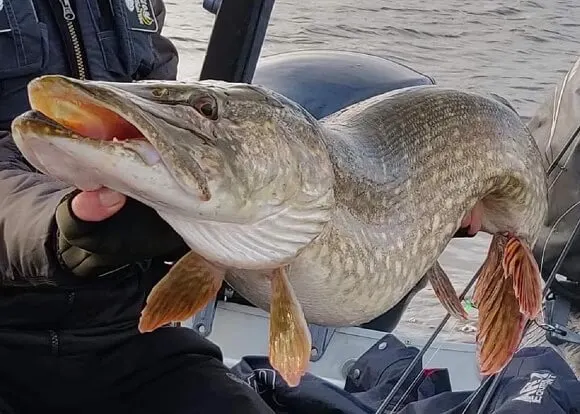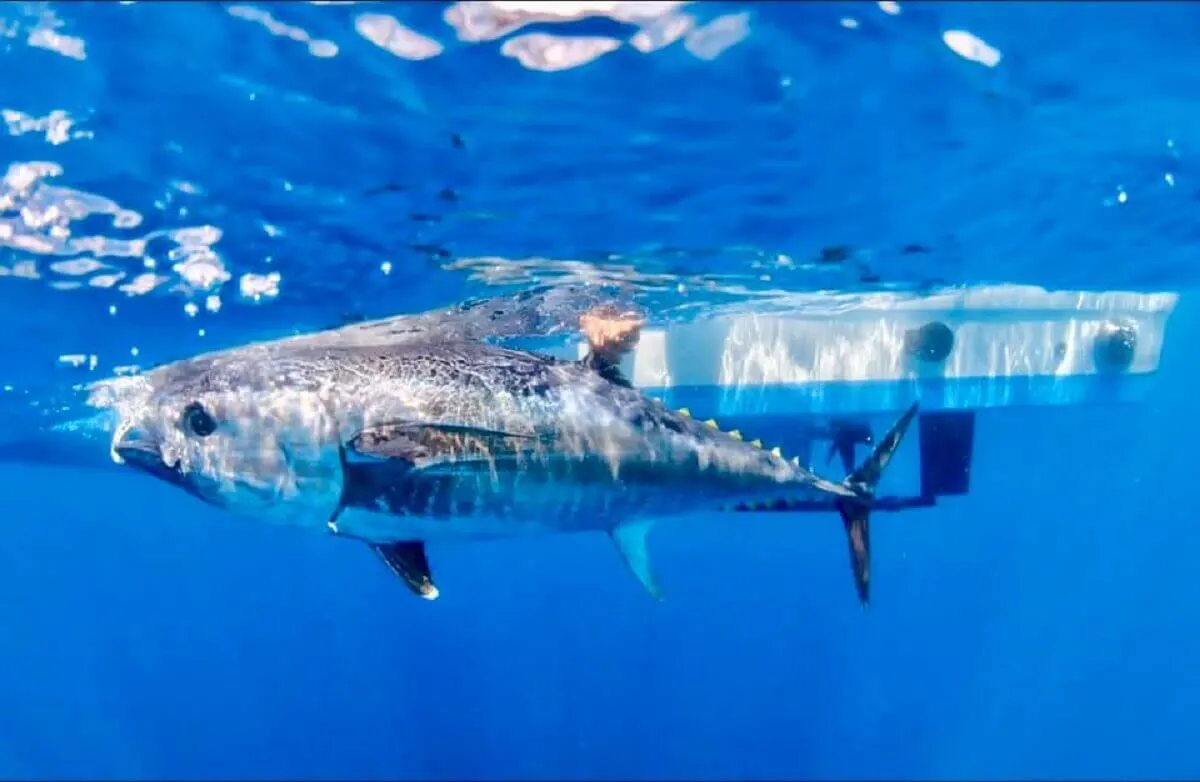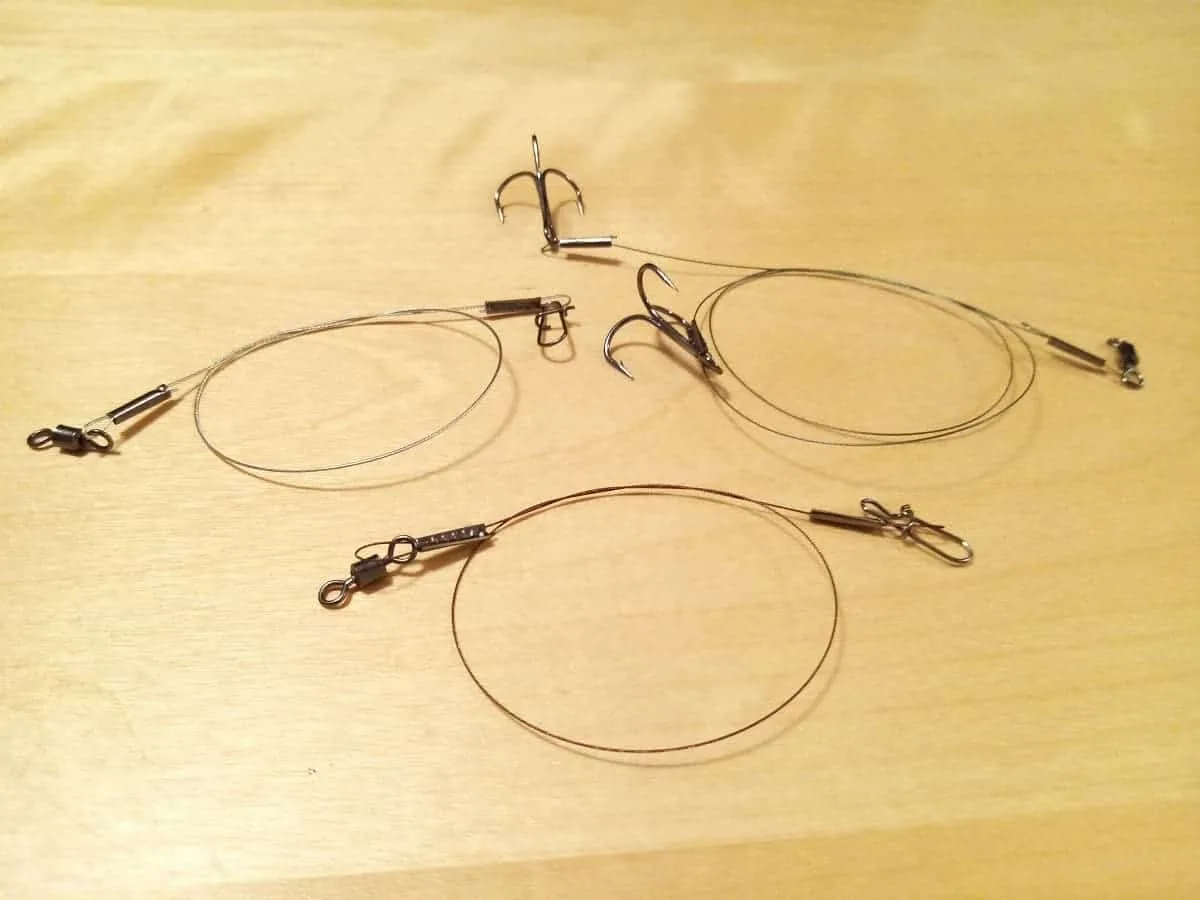Many anglers wonder if they actually need to fish with a wire leader, and if so, what type of wire material they are supposed to use.
In order to answer these much-debated questions, I decided to write this article, so that you will always know if and when to use wire leaders for fishing.
A wire leader is needed when targeting predatory freshwater or saltwater fish with sharp teeth. As such species will have no problem biting through conventional fishing line, using a wire leader will effectively ensure that you won’t lose your hook, lure, or fish.
Keep reading this article if you want to know all about wire leaders and the species that require using a wire leader.
Pro Tip: No matter what type of wire leader you decide to use, choosing a high-quality leader material is always a smart choice, as they will last longer and catch you more fish. My go-to wire leaders are made by American Fishing Wire, which has a super high standard. You can check out their best wire leader on Amazon here.
When Do You Need a Wire Leader?
When fishing for toothy predators, in both fresh- and saltwater, a wire leader is always good to use in order to prevent bite-offs.
No matter if you are fishing with lures, dead, or live baits, the risk of a predator’s teeth reaching your mainline and biting through it is always fairly high.
Neither does it matter if you are fishing your baits statically on a bobber or on the bottom, or retrieving your lures at a fast speed; you simply cannot know how, if, and when a predator will hit your lure or bait and how deeply it might swallow it.
So, instead of taking that risk and hoping for the best, putting a wire leader between your lure or bait and your mainline is the best way of making sure that you won’t have any line breaks due to sharp teeth.
Freshwater Species That Require Wire Leaders

The following freshwater predators should be fished for with a wire leader:
- northern pike
- musky
RELATED ARTICLE: Northern Pike Teeth (With Lots of Facts and Pictures)
However, using wire leaders for other species, such as walleye, perch, or bass, might also be necessary if the water you are targeting those species on also contains pike or musky.
Because you may not target those two predators, but as you are using lures and/or baitfish to catch these smaller predators, there is simply no way of telling if and when a big pike or musky decides to go for your bait or lure.
So, unless you are okay with losing the occasional lure or slip bobber rig, which will both cost you money and valuable time that you could have spent fishing, as you’ll have to rig up again or put on a new lure, fishing with a thinner and softer wire leader, if pike or musky are around, is never a bad idea!
Of course, you can also choose to use fluorocarbon leaders for your predator fishing, which many anglers prefer nowadays. If that’s the case for you, make sure to also check out this article I wrote: Best Fluorocarbon Leaders for Pike
Saltwater Species That Require Wire Leaders

Of course, there are plenty of saltwater predators out there in the seven seas, and I cannot list them all in this article. But here is a list of the most commonly fished saltwater species that require a wire leader:
- Sharks
- Wahoo
- King and Spanish Mackerel
- Bluefish
- Grouper
- Snapper
- Tuna
It goes without saying that these species require much stronger and thicker wire leaders than their freshwater equivalents; the bigger the fish, the stronger the leader.
RELATED ARTICLE: Make sure to also read this article with tons of facts about wahoo teeth!
What Type of Wire Leader Should You Use?
The type of wire leader you should be using for your fishing depends on both the species you are targeting and your intended fishing method.
Most commonly, wire leaders are made of either single-strand or multi-strand (1×7 or 7×7 strands) stainless steel or titanium, the latter being a leader material that has only recently entered the wider market.
Both of these materials have their pros and cons and each of them should be optimized and used in combination with specific fishing methods and target species.
Because if these leaders are fished the right way, they can and will catch you a lot more fish!
Single-Strand Steel Wire
Pros
This is the oldest of fishing wires and probably the most used one to this day. Single-strand wire is a very strong and tough leader material that will withstand many attacks by sharp-toothed predators.
It is also highly abrasion-resistant, which makes it durable and long-lasting.
Cons
Old fashioned single strand wire leaders are not very flexible and smooth, which means that they will kink and curl up fairly easily and fast.
Their inflexibility is also their greatest weakness, as this wire material can actually break if it gets too kinked.
Best Usage
Spin fishing sessions with fast-retrieved or trolled lures. Bring a few leaders with you on your trip, so that you can easily switch to a new one when your current leader in action is all curled and kinked up.
This way, you will always have the best lure presentation!
Single-strand steel wire works best for big saltwater predators with large teeth, such as sharks or wahoo.
Multi-Strand Steel Wire

Pros
This is a very flexible and smooth wire material that almost feels and bends like a conventional fishing line.
Its awesome flexibility results in an amazing bait presentation that can definitely catch you more fish.
Another great advantage of this type of steel leader is that thinner diameters are actually knottable, which, for certain methods, makes the use of swivels unnecessary.
Cons
As this leader type consists of many small, tightly woven strands, thinner diameters can actually break fairly easily, which is something to keep in mind when using a thin leader for smaller predators.
Personally, I wouldn’t go thinner than a 10lb test.
Its braided nature also makes it somewhat less abrasion-resistant.
Best Usage
Due to its great flexibility, multi-strand wire is great for live and deadbait fishing for bigger predators, as well as fishing for smaller predators.
Just remember to downgrade your leader diameter if fishing for e.g. walleye, perch, or bass.
Amazon has a great coated and well-camouflaged steel leader material that you can check out here.
Single-Strand Titanium Wire
Pros
As nickel-titanium leaders are very stretchy, they are a perfect fit for lure fishing. Their great stretch, which can be compared to that of monofilament line, helps to absorb the fish’s strike and has a small buffer effect when hooking it.
Another advantage that I really like is the fact that titanium leaders usually come in non-reflective black, which camouflages the leader well underwater.
Titanium leaders are also very durable, cut-proof, and kink far less than steel leaders.
Cons
Its stretchy nature does not make it an optimal leader for live and dead bait fishing, as you will want to set the hook as fast and effective as possible.
Also, as titanium is such a high-grade material, it is a bit more expensive. On the other hand, you can use it far longer than conventional steel leaders, thanks to its great durability.
Best Usage
Faster spin fishing is definitely the best method to use single-strand titanium leaders for.
As this leader material comes in thicker test pounds, of 15-20lb and upward, it is best suited for bigger fresh- and saltwater predators, such as pike, musky, tuna, wahoo, grouper, or sharks.
American Fishing Wire’s single-strand titanium leader is without a doubt one of the best and strongest wire leaders on the market! I use this leader myself when spin fishing for pike. It’s really outstanding!
If you are in need of reliable and top-quality titanium leaders, you can find them on Amazon here.
Multi-Strand Titanium Wire
Pros
Much like single-strand titanium, multi-strand titanium is extremely durable. It is also fairly stretchy and even more flexible than the single-strand variant.
Another great plus of this type of wire leader is that it is corrosion-resistant, which means it will last for a very long time, making it highly cost-effective.
The third advantage of multi-strand titanium wire is that you can knot it.
Although, as the diameter of such leaders is usually thicker than that of stainless steel leaders, I advise against directly knotting it to your lures or hooks. It’s just too much effort for too little gain.
Cons
Like single-strand titanium, multi-strand leaders usually also come with a thicker diameter and higher pound test, which makes reduces the number of species that you can target with them to only the bigger ones.
Other than that, it’s really hard to find any other negative aspects of using multi-strand titanium. It’s as close to the perfect wire leader as you can get!
Best Usage
If you want to fish your lures or softbaits more lively and natural, you can definitely use this type of titanium wire. Otherwise, I would say that the perfect method for this leader is trolling with big lures, as well as bigger baitfish.
As multi-strand titanium leaders can go beyond the 100lb test mark, you can use them for all types of big and sharp-toothed predators in both fresh- and saltwater.
Can You Use Ready-Tied Wire Leaders?
There is an array of ready-tied wire leaders out there, both of the stainless steel and titanium variety. Using qualitative ready-tied leaders can save you the time of making them yourself, which can be highly advantageous when you’re out fishing.
However, as I’ve tried many such leaders over the years, I want to recommend you to only use proven and good quality ready-tied leaders.
Too many times have I lost big fish with low-quality leaders that either broke, corroded or had poorly attached and/or low-quality swivels attached to them.
It’s very frustrating and I don’t want you to have to experience those fish losses and bite-offs! When I use ready-tied wire leaders, I use one that I can trust 100% while fighting a big fish.
You can find it and take a closer look at it on Amazon here
Can Wire Leaders Break?
There is always a small risk that your wire leader can break while fighting a fish. It all depends on the quality and durability of the leader material, as well as on how long you’ve been using it.
Steel wires can corrode after a certain time in the water, especially in salty water, which, in turn, can lead to a leader break.
Another wire break scenario includes a leader that is kinked and hence can have a few weak points on it.
If a strong and wild predator with very sharp teeth goes to work on that leader, there is a definite risk of a bite-off.
Similarly, leaders that you have caught many fish with can get weaker over time and eventually break.
This is why it’s so important to always check your leader for abrasion and weak points, as well as to use top-quality tackle. If you do that, you will keep your leaders intact and catch more fish!
Related Article: 5 Best Wire Leaders for Northern Pike
Do Wire Leaders Scare Fish?
As many leaders are coated or come in dark, low visibility colors, they do not seem to scare the fish you target.
I have run many experiments where I fished for predators with both thick fluorocarbon leaders and wire leaders, and the results were exactly the same on both materials.
The only time a fish could get wire shy is if you are targeting a smaller predator species (e.g. walleye or perch) with a wire leader that is too thick.
Walleye especially are known for being fairly wire and line shy, which is why you should use a wire leader that is as thin as you can get away with.

